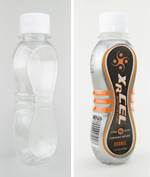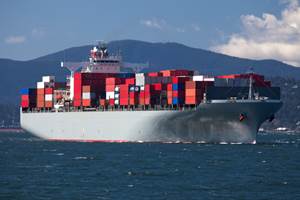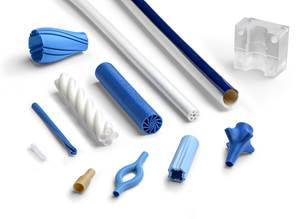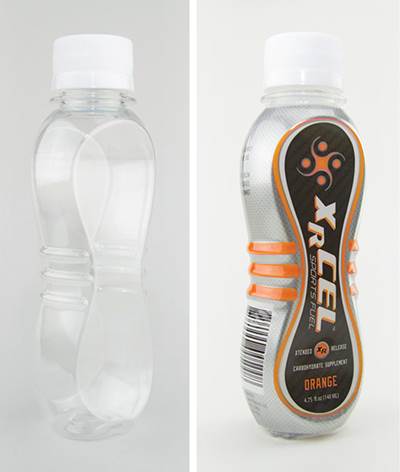As Currier Grows in Medical Consumables, Blow Molding Is Its ‘Foot in the Door’
Currier Plastics has added substantial capacity recently in both injection and blow molding for medical/pharmaceutical products, including several machines to occupy a new, large clean room.

“Medical is a big growth area for us,” says Rob Knapp, Currier Plastics sales and marketing manager. “There are relatively few custom contract manufacturers out there in medical blow molding. So blow molding is our foot in the door with medical customers. Then we get their injection molding business.”
Photos: Currier Plastics
One often hears the medical market referred to as the medical “space.” For Currier Plastics, its medical “space” is growing—both literally and figuratively. Driven by growing demand for plastic consumables in healthcare, the company (currierplastics.com) is remodeling a newly purchased 75,000-ft2 building near its headquarters in Auburn, N.Y. Besides offices and warehouse space, its main feature will be a 25,000-ft2 ISO Class 8 cleanroom to house both injection and blow molding machines. When it opens early next year, it will supplement Currier’s existing 9000-ft2 Class 8 cleanroom.
“Currier has become a leading provider for complex, precise consumables in several healthcare markets. This expansion will give us the place to grow more strong, valuable partnerships,” says Ron Ringleben, v.p. of business development.
Adds Rob Knapp, sales and marketing manager, “While the focus of the new facility is driven by the demand in the healthcare space, this new facility will allow us to continue to support our key customers in other spaces like general packaging and amenities.”
‘Our Foot in the Door’
Currier recently celebrated its 40th anniversary. Starting in 1982 as a custom injection molder, the firm added extrusion blow molding (EBM) in 1996 and injection stretch-blow molding (ISBM) in 2010. Early last year, it purchased its first injection-blow molding (IBM) machine. Currier used to have accumulator-head blow molders but got out of that area of blow molding. “But now we’re looking at it again,” Knapp says.
Currently, the firm has 40 injection presses from 44 to 500 tons, plus 25 EBM machines, eight Aoki ISBM presses, and a Jomar IBM machine—for a total of 34 blow molders, which generate a majority of the firm’s $60 million annual revenue (a figure that has doubled since 2014).
Over the past three years, since the start of the pandemic, Currier has added five all-electric EBM machines (three Magic units for medical use and two Kautex KBB presses for nonmedical jobs), one Jomar IBM machine, and around 15 injection machines.
“It’s kind of unique to have extrusion blow molding inside the cleanroom.”
While Currier produces containers and caps for general packaging—such as candy containers and hotel amenity bottles for shampoo, mouthwash etc.—along with some legacy business in electronic connectors, medical has become a major component of its business since 2017. Currier specializes in consumables for in-vitro diagnostics (IVD), point-of-care (POC) testing and life-science markets. These include injection molded sample cups and specimen tubes and caps for Covid testing, as well as blow molded bottles for reagents, cleaning solvents, pharmaceuticals etc.
“Medical is a big growth area for us,” says Knapp, “and there are relatively few custom contract manufacturers out there in medical blow molding. So blow molding is our foot in the door with medical customers. Then we get their injection molding business.” Three large medical customers expanded from blow molding to injection with Currier in this fashion.
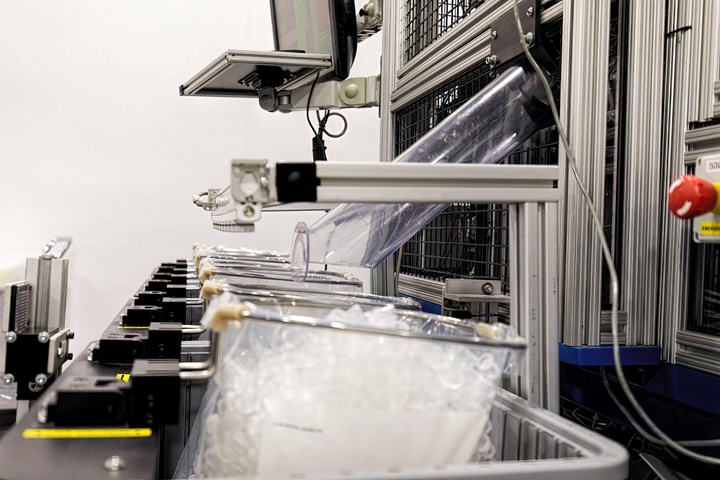
Currier’s existing cleanroom houses injection molding and EBM machines. The new, larger cleanroom may also have an ISBM machine inside.
Inside the existing cleanroom, Currier operates five injection machines and the IBM press, as well as a Magic EBM machine. “It’s kind of unique to have EBM inside the cleanroom,” Knapp states. “We also have smaller Magic EBMs that are separately surrounded by clean tents.” The new, larger cleanroom will have injection and EBM machines, and Currier may even move one of its Aoki ISBM machines in there to mold PET and PC parts. Automated assembly will be added to the cleanroom in the future. Seven additional injection presses outside the cleanroom are dedicated to medical/pharmaceutical work.
Facing Today’s Challenges
The last three years have been trying for all manufacturers, Currier Plastics included. Supply-chain challenges were at the top of the list. “Last year we were on allocation for some materials,” recalls Knapp. “This year we’ve had to deal with 10-15% increases in costs of pallets and boxes. Wood pallets were so hard to get that we almost had to shut down a manufacturing line.”
While Covid brought staffing shortages for many manufacturers, Currier fared better: “We’re in good shape with labor,” says Knapp. “We eliminated temporary labor because it’s too volatile. We increased wages to hold onto talent. We recently reintroduced Level 1, 2 and 3 training from Routsis Training, which we had paused due to Covid. This seems to help hold onto people.”
Currier held six open interview sessions for prospective employees over a six-week period. From seven to 18 people showed up for each session. “Manufacturing jobs are a tough sell,” notes Knapp. “It’s good to show people that we’re not your grandfather’s factory anymore—our plant is clean, safe, largely automated.”
One of today’s challenges is relatively new but growing. “We get a lot of questions from customers about sustainability,” Knapp reports. “It used to be all you had to do was provide a good product at a good price. We work with customers’ engineering teams to ensure good quality, but now they have a whole team devoted to sustainability.”
“PCR is expensive and hard to get. We are trying to move some customers into PIR based on our own internally generated scrap.”
To help address questions related to ESG (environment, social, governance), Knapp points out, “Most of our machines now are all-electric, which saves energy. Most of our boxes are 100% recycled material. We are exploring returnable packaging—plastic totes. We have all energy-efficient LED lighting. We make sure we’re not wasting water. We make sure we’re following proper labor regulations.”
With regard to recycling, he adds, “There’s a lot of movement into PCR (post-consumer recycle) but it’s expensive and hard to get. We are using PCR on a day-to-day basis—25% to 50% in some products, mainly larger HDPE bottles. Given the supply issues for PCR, we are trying to move some customers into PIR (post-industrial recyle) based on our internally generated scrap. We invested in large industrial granulators to reuse our production waste.”

A new 75,000-ft2 building, due to open in early 2023, will have a 25,000-ft2 Class 8 cleanroom, almost three times the size of Currier’s existing cleanroom.
Related Content
What to Look for in High-Speed Automation for Pipette Production
Automation is a must-have for molders of pipettes. Make sure your supplier provides assurances of throughput and output, manpower utilization, floor space consumption and payback period.
Read MoreRecord Reshoring Rates in 2022
Reshoring and foreign direct investment (FDI) in the third quarter marked their highest ever level, eclipsing the previous record set in the second quarter of 2022.
Read MoreDuPont Buys Medical Product Manufacturer Spectrum Plastics
Purchase price of $1.75 billion for leading supplier of extruded, molded, and 3D printed medical components.
Read MoreBaxter to Scale Up PVC Intravenous Bag Recycling Program
Successful pilot program with Northwestern Medicine will expand to additional units and health systems.
Read MoreRead Next
How Currier Puts the ‘Custom’ In Custom Blow Molding
The three key ingredients are responsiveness, full-service product development, and control over both the bottle and the cap.
Read MoreOn-Site: Custom Molder Pursues the Dream of Proprietary Products
“Every custom molder thinks he needs a proprietary product,” says John Currier, president and co-owner of the injection molding firm his father founded, Currier Plastics in upstate Auburn, N.Y.
Read MoreTwo Molders Investing in Medical Market
Currier Plastics and NPI/Medical invest in clean rooms; molding and blow molding machines; testing equipment and more.
Read More

